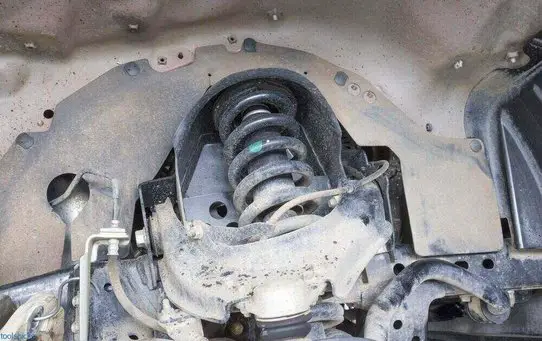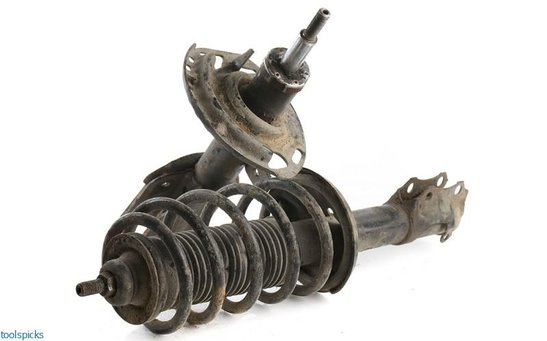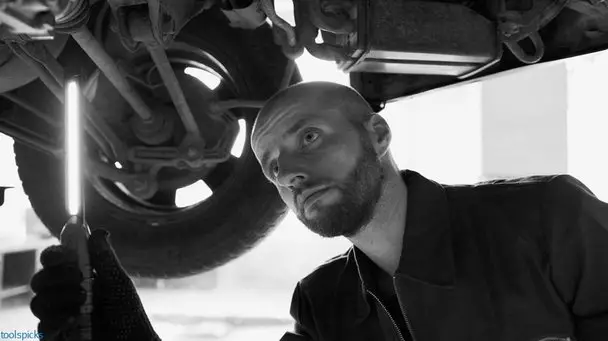Suspension problems often mimic other types of mechanical issues in a vehicle. They could be caused by pre-existing mechanical issues or cause issues. Therefore, they can be difficult to identify.
This article will discuss the most common signs that your suspension system or components are bad. It will also discuss some tests and inspections you can conduct to establish if the suspension is bad.
Top Signs Your Vehicle’s Suspension Is Bad
Excessively Bumpy Rides
The main purpose of the suspension system is to isolate vibrations to ensure a comfortable and smooth ride. Therefore, if the suspension system is damaged, you will notice that your rides become bumpier and rougher than usual.
The shock absorbers and struts may be worn out, requiring replacement. However, a bumpy ride can also be caused by inappropriate tire pressure. So, you want to confirm that the tire pressure is right to eliminate it as a possible cause of the bumpy ride.
Squeaking and Creaking Noises
Aside from a bumpy ride, you may notice that the car produces some noise. It may be squeaking from the bottom as you ride on smooth surfaces or as you take turns. If the lower ball joint is bad, you may hear squeaking noises when you turn the wheel. On the other hand, a knocking sound when turning the vehicle may be caused by a faulty sway bar end link.
Cumbersome Steering
Cumbersome steering may also be an indicator of a faulty suspension. The suspension works in tandem with the steering system to ensure responsive driving. Therefore, if it is faulty, it can affect the steering response making it cumbersome to make turns. Damaged tie rods will particularly make steering difficult.
Uneven Tire Wear
Another indicator of a faulty suspension is uneven tire wear. Ideally, all the tires should wear evenly across their width. If you notice that one side of the tire—either the inner or outer side—is wearing out faster than the other parts, it could indicate an issue with the tire or wheel camber.
Camber refers to the wheel’s angle on the road and the vehicle. It is affected by both wheel alignment and the suspension system. If the camber is negative, the tires tend to wear more on the inner side. Conversely, if it is positive, it wears more on the outside. Uneven tire wear can also be caused by wheel misalignment.
Nose Dive or Body Roll to the Front When You Brake
Test if the suspension is working properly by observing if there is a nose dive when you brake. It is normal to have some level of nose dive when you brake your car abruptly; however, if it is too pronounced, there might be an issue with the suspension.
A bad suspension will have difficulty holding the car’s weight, resulting in a forward and downward lunge. You may also hear a clunking sound at the front side of the vehicle. A nose dive often happens if the struts or shock absorbers are damaged, while the clunking noise is often a result of a damaged subframe bushing or control arm.
Swaying or Bouncing at Low Speed or When Going Over Bumps
Pay attention to how your car drives over bumps or at low speeds. If it tends to bounce or sway when going over the bump or shortly after, it is obvious that the suspension is having a challenge with supporting the weight of the car. Also, notice if the car tends to sway when driving on a straight road. Drifting or swaying can also be caused by wheel misalignment or low tire pressure.
One Side of the Car Sits Lower Than Other Sides
Park the car on level ground and inspect it to see if one or more sides sit lower than the others. If so, it could be that the suspension springs on the particular side are damaged. You may also notice that the hood on the specific side may be too close to the tire. Damaged springs can also be evidenced by a clunking noise when driving over a rough section of the road.
How to Check if the Suspension Is Faulty
If you notice any of the above signs, there are some tests or inspections you can conduct yourself to confirm if the suspension system is faulty. Below is an overview of ways to check if your suspension is bad.
Bounce Test
You will need to conduct the bounce test at the front and back of the car. Ensure that the car is positioned on level ground. Place both hands firmly on the bonnet and exert your entire weight to push down the front of the car. Count the number of times the car bounces before reaching a standstill. If it bounces more than thrice, then the suspension is faulty.
Next, go to the back of the car. Stand at the back and push the boot downwards. Once again, count the number of times the car bounces. As with the front bounce test, it should not bounce more than thrice.
Check the Shocks for Oil Leakage
The struts and shock absorbers have a fluid that helps to dampen the bouncing. If there is a leak in the fluid, then the suspension system’s efficiency is lowered. Therefore, inspect the shocks and struts for any greasy parts that may evidence oil leakage.
Check if the Car Is Level
As mentioned in the signs of a bad suspension, if one side of the car sits lower than the other, yet all the tires are equally inflated, the suspension may have an issue. Sometimes the imbalance is obvious, but if it is not, you may need a keener investigation.
Ensure the car is on level ground. Using a tape measure or a ruler, measure the ride height of each wheel across the center—from the bottom of the fender to the bottom of the tire. Ideally, the measurement you get at each wheel should be the same.
However, a variance of about half an inch or less is allowable. If the variation is too significant, there is an issue with the suspension side where the ride height is lower.
Inspect the Entire Suspension System
Start by inspecting the front shocks and strut mounts. Open the hood of your bonnet and identify the strut mounts. In most cars, the mounts or shock towers are located above the wheel. Check if the fasteners are rusted or loose.
Then inspect the tie rod ends. They connect the wheels and steering box. Therefore, if the bushings on the ends are worn out, it can result in stiff steering wheel handling or a blindspot. Extremely worn-out tie rods are dangerous as they can cause a complete failure in your ability to steer and control the car.
To locate the tie rod ends, identify the power steering box and follow the arm to where it leads towards the wheel. Or refer to your vehicle’s manual.
Another thing to inspect in the front suspension is rubber bushings that separate the various metal components. For this, you will need to get under the car. Ensure it is firmly jolted up using a jack and jack stand. The bushings are easy to identify as they are usually black or may have turned grey over time. They have a donut-like shape—round with a small hole in the middle.
If the bushing is worn, cracked, or missing, it needs to be replaced. Bad bushings can compromise the operation mechanism of the suspension system as it allows more movements between the components. It can also compromise steering.
Once done with inspecting the front side, proceed to inspect the rear suspension. You will need to jack up the car’s rear side at the designated jack points to get safe access to the rear suspension.
Just like with the front suspension, check the bushings for damage. You may need to wipe the various suspension components to get rid of dirt or grease that may be covering the joints. Then proceed to check the bolts and nuts for rust or looseness. Also, check the frame of the suspension for rust.
Take Your Car to the Mechanic for Inspection
Ultimately, a thorough inspection and road test by an experienced mechanic is the most accurate way to establish the condition of your suspension. Besides, to inspect the car yourself, you would need basic to intermediate mechanical skills to make the right diagnosis. A reputable mechanic has the skills and experience to point out the exact issues and resolve them promptly.
Conclusion
If you notice that your car rides are bumpier than usual or that the car has some squeak and clunks, don’t wait it out. Inspect the car or have a mechanic inspect it for you to determine if the suspension is faulty. Suspension maintenance and issues are often overlooked but can be extremely dangerous if left unattended.



